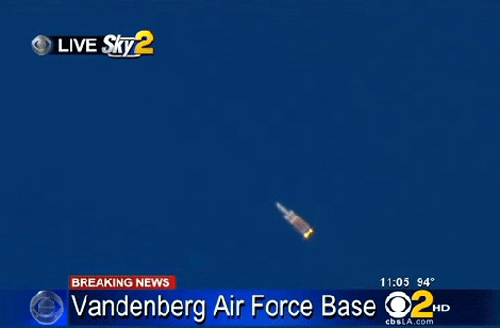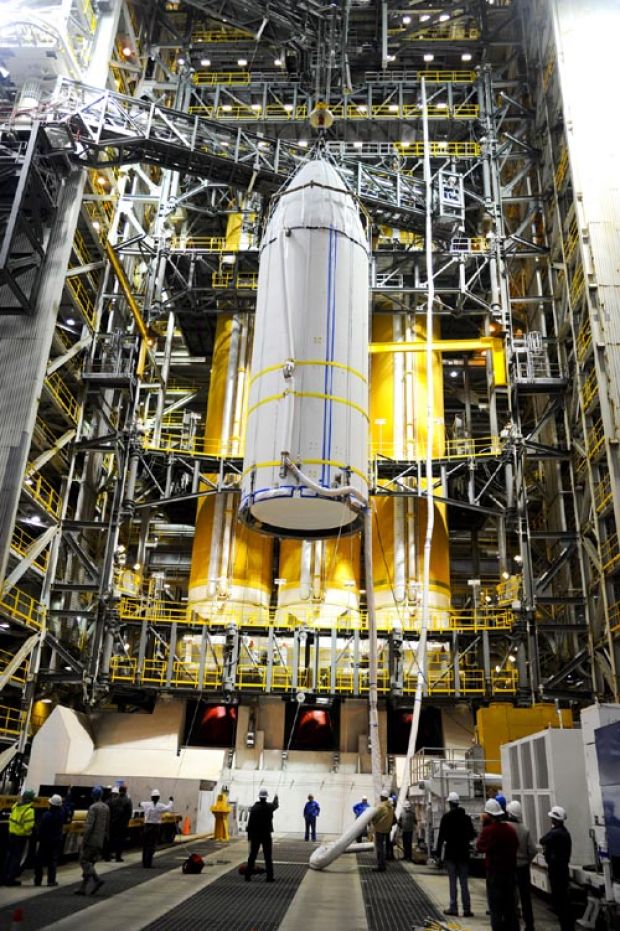A monstrous rocket aims to make its second departure from Vandenberg Air Force Base on Wednesday, a launch date that has remained firm even as crews wrestled with scheduling challenges caused by sequestration.
The Delta 4-Heavy rocket’s blastoff is planned between 10 a.m. and noon Wednesday from Space Launch Complex-6 on South Base. The former space shuttle launch pad is tucked in a canyon and isn’t visible from around the Lompoc Valley.
The booster, topping 230 feet tall and built by United Launch Alliance, will carry a top-secret spacecraft into orbit for the National Reconnaissance Office.
“Right now, there are no major issues that we’re working or that are threatening the launch,” said Lt. Col. James Bodnar, who took command of the 4th Space Launch Squadron in July.
The days leading up to launch are busy with assorted reviews at various levels to ensure the rocket and its payload are ready for liftoff.
“The launch business is probably one of the most risk-adverse businesses out there ...,” Bodnar said. “The extra time the reviews take are well worth the cost because the alternative is unthinkable.”
Setting — and keeping — a launch date months or years ahead of time can prove challenging.
But the Delta 4-Heavy team has wrestled with a new wrinkle for this campaign. For six weeks in July and August, key Department of Defense civilians were restricted to working just 32 hours a week due to federal furloughs as part of sequestration cutbacks..
Airmen primarily make up the 4th Space Launch Squadron, but a civilian is serving as Air Force launch director for this mission.
“We had to be very careful, and sometimes creative, to make sure that all the operations were covered and all major meetings and other milestones were covered,” Bodnar said.
More so than other missions, they relied on the deputy Air Force launch director — an Air Force officer — to cover some of the meetings.
In some cases, they had to schedule chores to avoid weekend work or furlough-related down days for some contractors.
“It’s just took more attention to work through all of those things,” said Bodnar. “We didn’t impact launch date, we didn’t find any major hurdles along the way, but it really forced us to examine all of our processes.”
Across the team of military, civilians and contractors, a blastoff is a momentous occasion because of the hard work that goes into making the mission occur.
“Launch isn’t just something that happens on launch day,” Bodnar said.
Along with installing the rocket and payload, the team conducts multiple exercises and tests.
“The fact that we actually get to see the fruits of all of that labor is actually amazing. They’re awe-inspiring,” Bodnar said, standing near workers for whom a blastoff represents years of work. “Rarely do you see dry eyes when the rocket launches and you know that it’s successful.”
This will be the second Delta 4-Heavy launch from Vandenberg.
The West Coast’s inaugural Delta 4-Heavy launch in January 2011 didn’t rattle the Central Coast as some spectators expected.
“There’s nothing bigger that the United States launches — period — in any way, shape or form, and that is absolutely amazing. However with new technology comes some efficiency ...,” Bodnar said, noting it can’t be compared to the retired Titan 4 or space shuttle, known for their loud rumbling upon liftoff.
“The Delta 4-Heavy with its liquid oxygen and liquid hydrogen engine burns incredibly clean, is remarkably quiet for the size of the rocket and does an incredible job of reducing the vibration and the noise that the payloads actually see as we launch these into space,” Bodnar added.
Delta 4 is designed with a Common Booster Core as its heart, topped with a second stage and payload. But the Delta 4-Heavy employs three Common Booster Cores strapped side by side.
At 150 feet long and 17 feet in diameter, each Common Booster Core is the size of a Boeing 727 fuselage, United Launch Alliance officials note. The 235-foot-tall rocket produces 2 million pounds of thrust at liftoff, the power equivalent of 33 Hoover Dams, ULA officials added.
Delta 4 rockets, along with Atlas 5’s, were developed under the Air Force’s Evolved Expendable Launch Vehicle ( EELV) program designed to simplify boosters and reduce costs.
Quelle: USAF
.
Update: 24.08.2013
The planned blastoff time for the Delta 4-Heavy rocket from Vandenberg Air Force Base is 10:52 a.m. Wednesday, officials said.
The United Launch Alliance rocket will carry a National Reconnaissance Office payload from Space Launch Complex-6.
The actual launch window remains classified but reportedly doesn’t extend past noon Wednesday.
Col. Keith Balts, 30th Space Wing commander will be the launch decision authority.
"This will be the second Delta IV-Heavy launched from Vandenberg," said Balts. "We are excited to showcase this national capability for heavy lift on the Western Range in support of the NRO. This is what makes Vandenberg unique because we provide the full spectrum of space lift capabilities from smaller launch vehicles up to and including the Delta 4-Heavy."
Quelle: Santa Maria Times
.
Update: 26.08.2013

America's largest rocket set for launch Wednesday
Igniting its three main engines in a staggered sequence for the first time, a United Launch Alliance Delta 4-Heavy rocket for U.S. national security is scheduled for liftoff from California on Wednesday morning.
The six previous launches of Delta 4-Heavy rockets -- five from Cape Canaveral and one from Vandenberg -- commanded all three engines to ignite simultaneously.
The earlier Vandenberg launch in 2011, however, saw the ignition plume catch external insulation on fire as the vehicle lifted off and cleared to the pad. The flames extinguished a few seconds later and the mission proceeded successfully.
The staggered engine sequence is meant to prevent such a reoccurrence without altering the engines' operations during flight, providing a cleaner and less dramatic launch.
The debut of this procedure on the East Coast will be made next year when a Heavy launches NASA's Orion deep-space capsule on a three-orbit shakedown cruise around the Earth.
Each engine guzzles nearly a ton of propellants per second to produce 656,000 pounds of sea-level rated thrust. The upper stage, with its Aerojet Rocketdyne RL10B-2 engine, takes over about six minutes into flight.
Wednesday's mission, flying southward from Vandenberg, will place a classified payload into polar orbit for the U.S. National Reconnaissance Office, the agency responsible for operating the country's fleet for spy satellites.
The Delta 4-Heavy is America's largest unmanned rocket currently in service, capable of lofting the biggest and heftiest cargos. The mammoth vehicle is created by taking three Common Booster Cores -- the liquid hydrogen-fueled motor that forms a Delta 4-Medium's first stage -- and strapping them together to form a triple-barrel rocket, and then adding an upper stage.
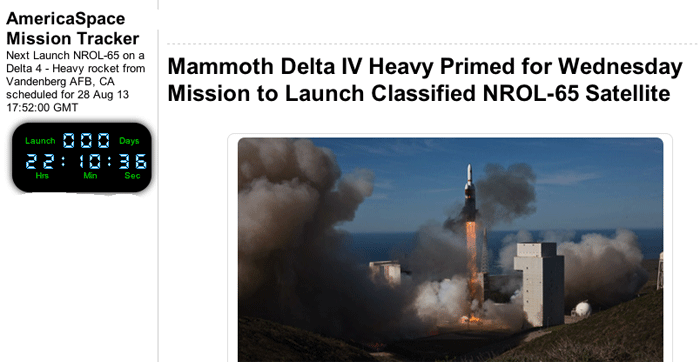
.
Update: 28.08.2013
.
Monster rocket to blast off from Pacific coast, rattle Southland
.
The nation’s largest rocket is ready to blast off from Vandenberg Air Force Base north of Santa Barbara, carrying a massive, top-secret spy satellite for the federal government.
As early as 10:52 a.m. Wednesday, the 235-foot Delta IV Heavy rocket will lift off from the base's Space Launch Complex 6, leaving a thick white plume over the Pacific.
The rocket, the tallest ever to be launched from the base, is set to place a classified spacecraft into polar orbit for the National Reconnaissance Office, the covert umbrella agency that operates spy satellites.
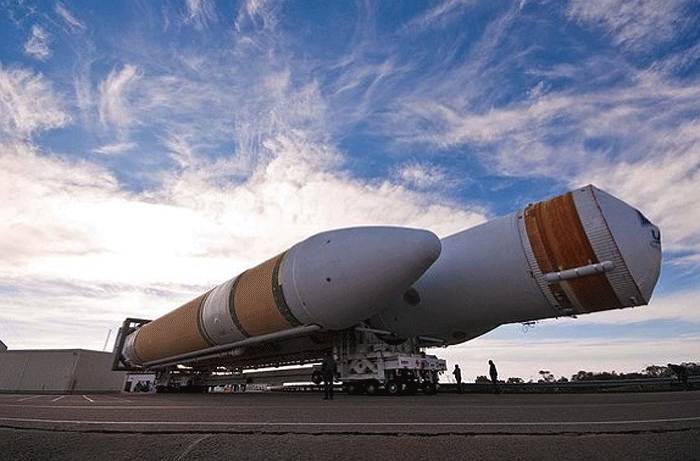
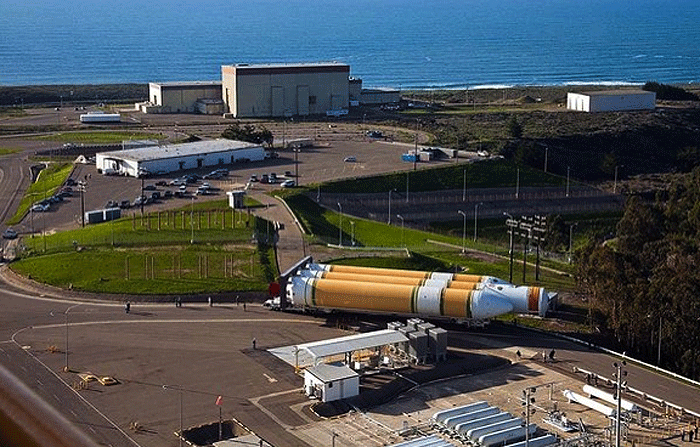
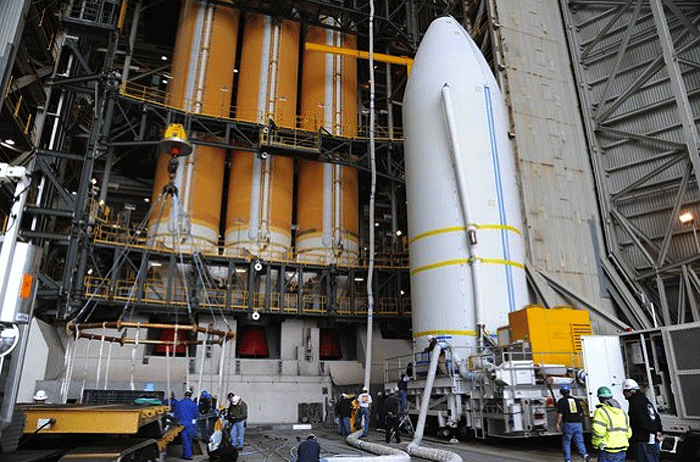
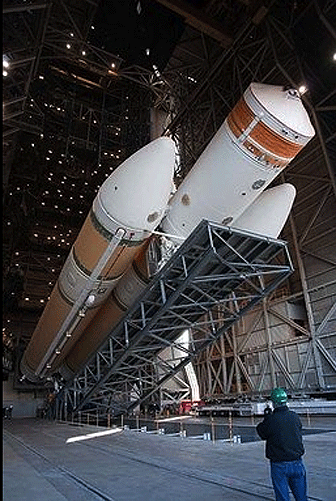
.

.
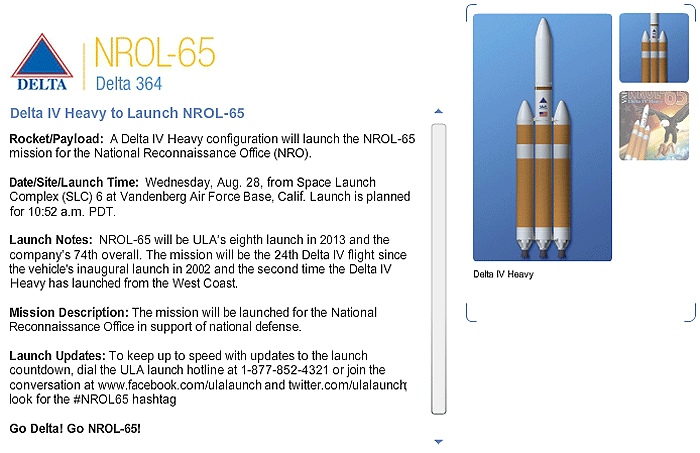
Quelle: ULA
.
Update: 28.08.2013 / 22.30 MESZ
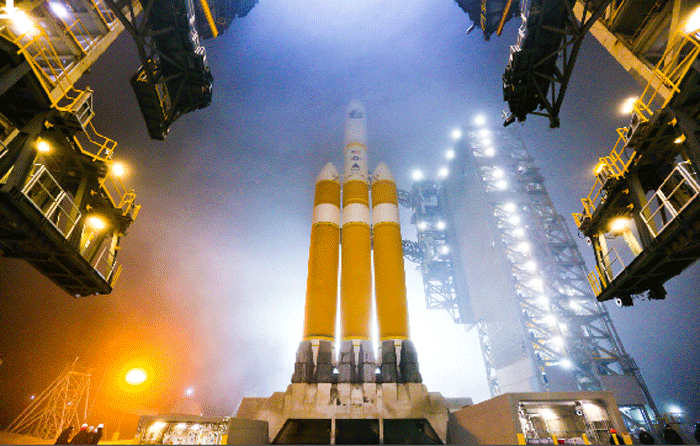
.
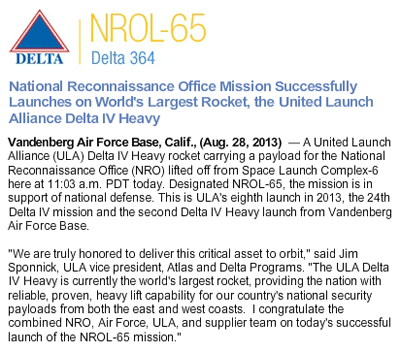
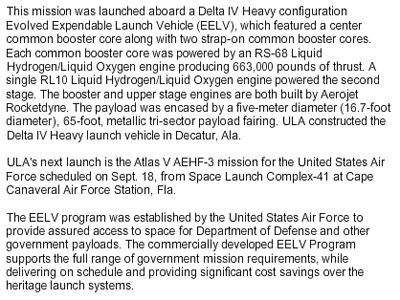
.
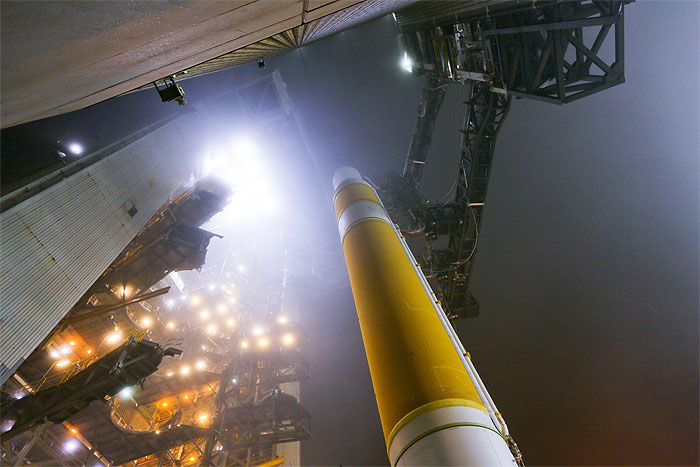
.

.
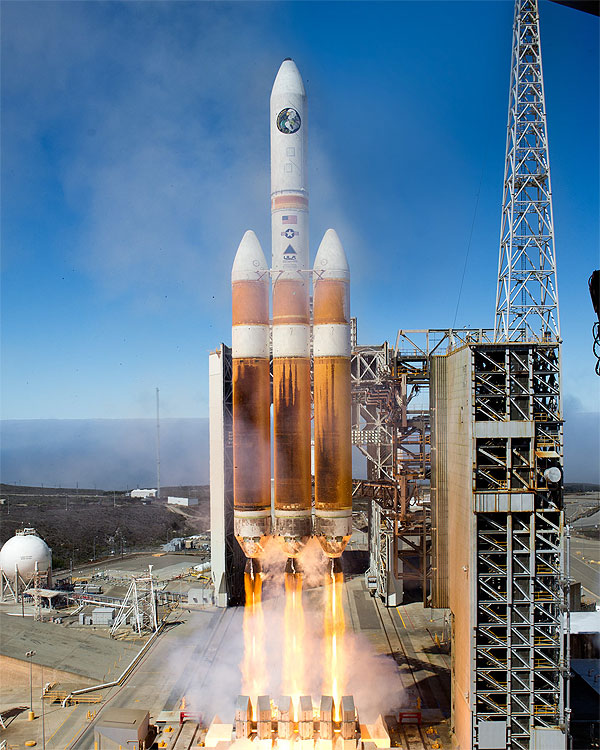
.
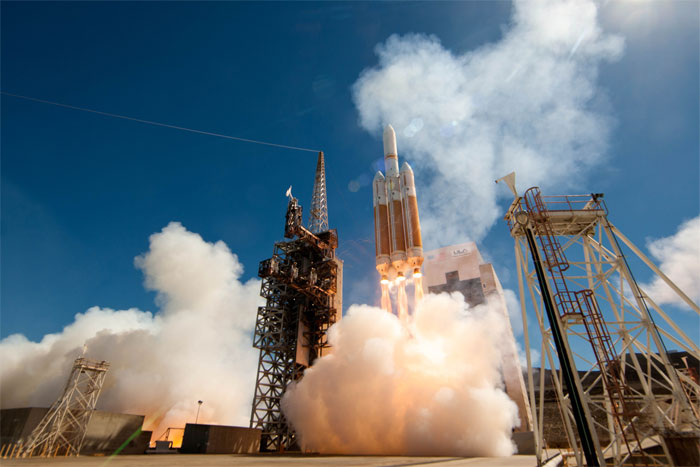
.
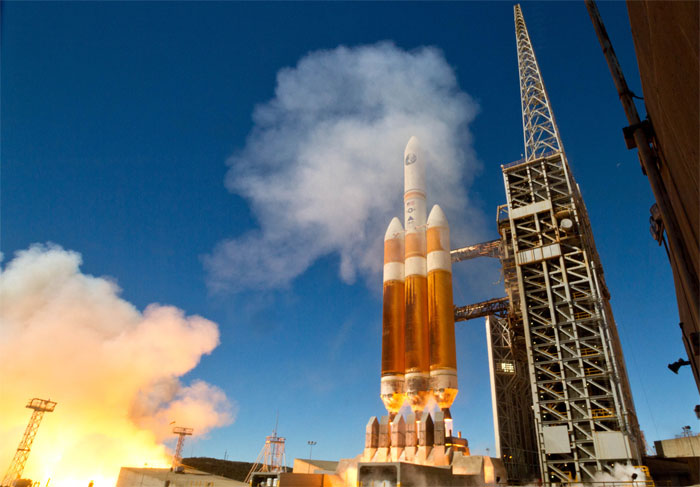
.
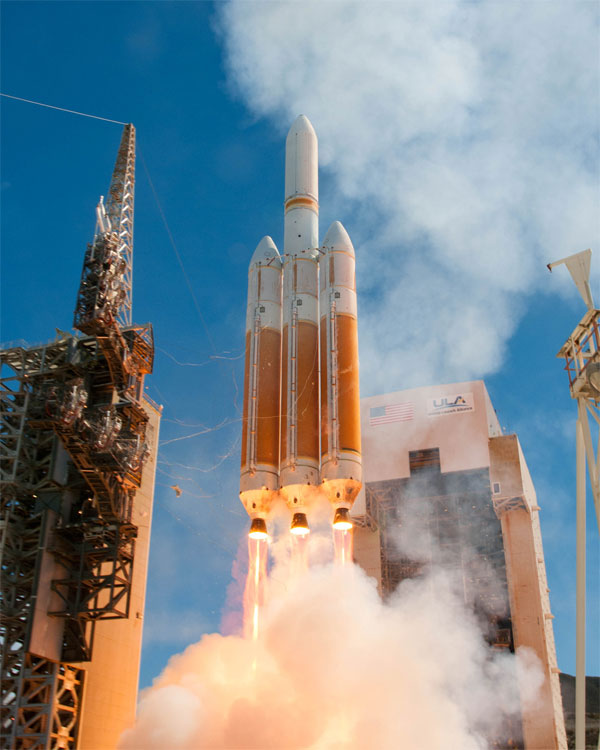
.

Quelle: ULA
.
Update: 29.08.2013
.
Frams: Start-Video Sky2
.
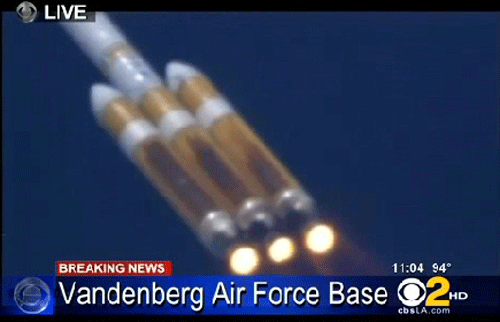
.
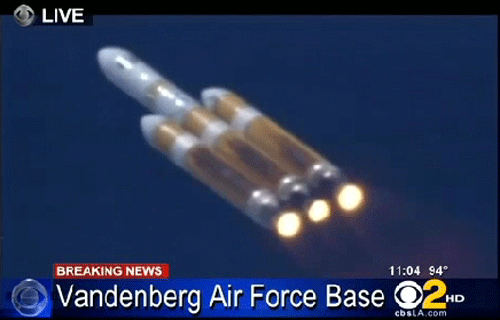
.
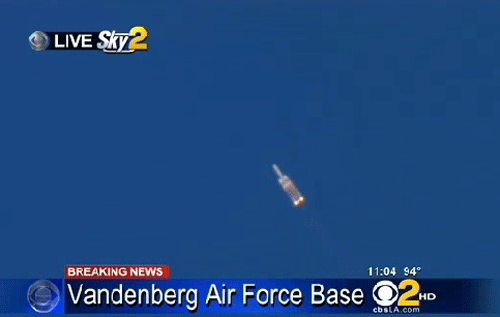
.
